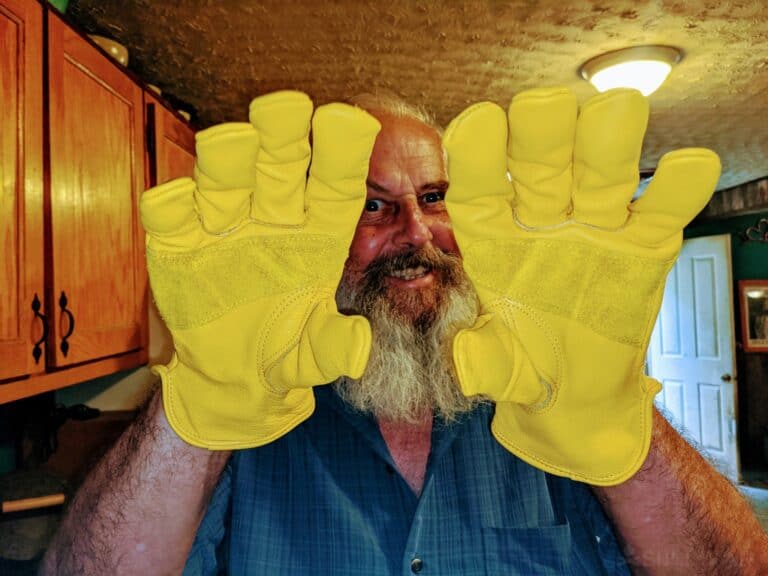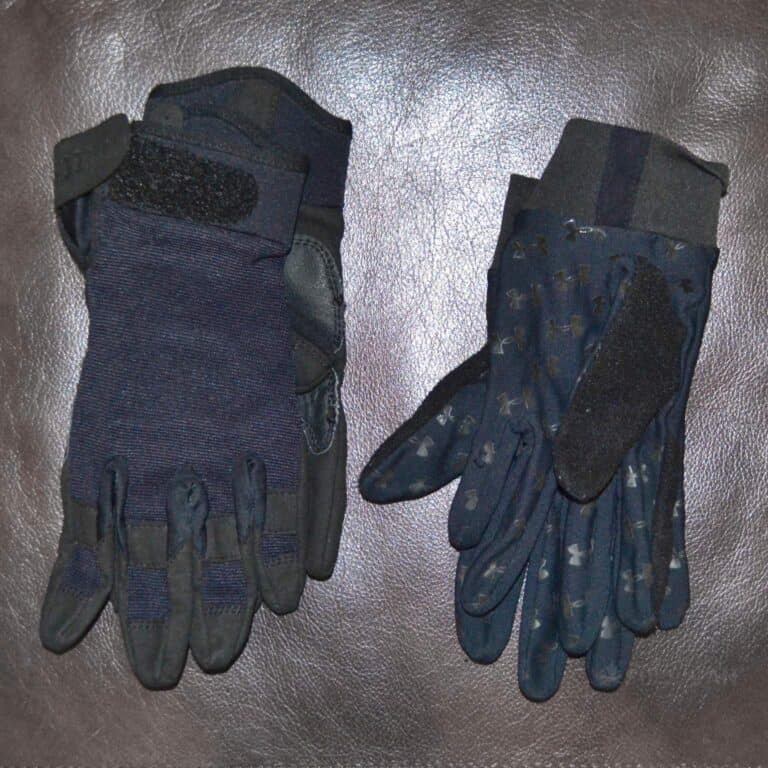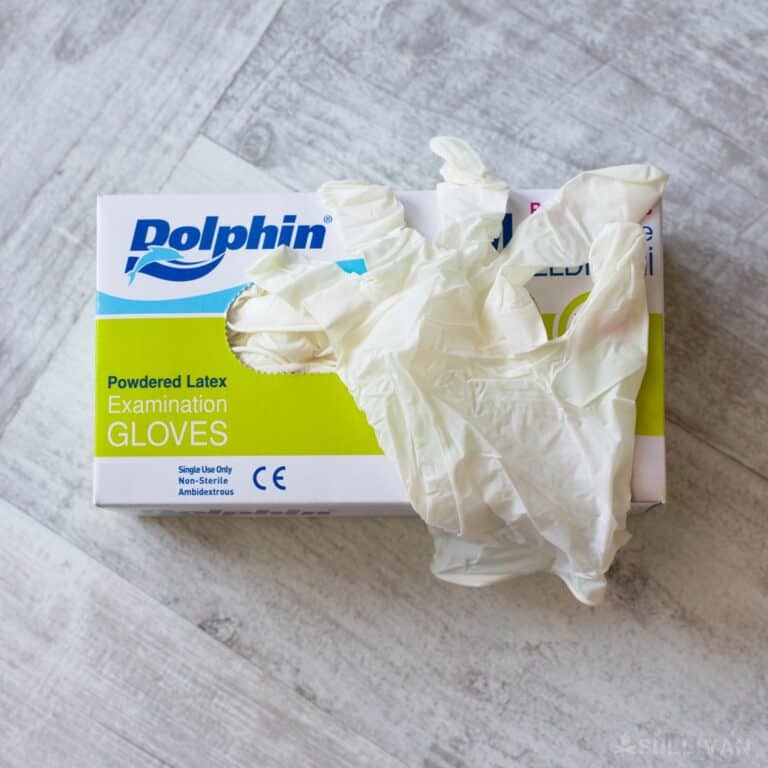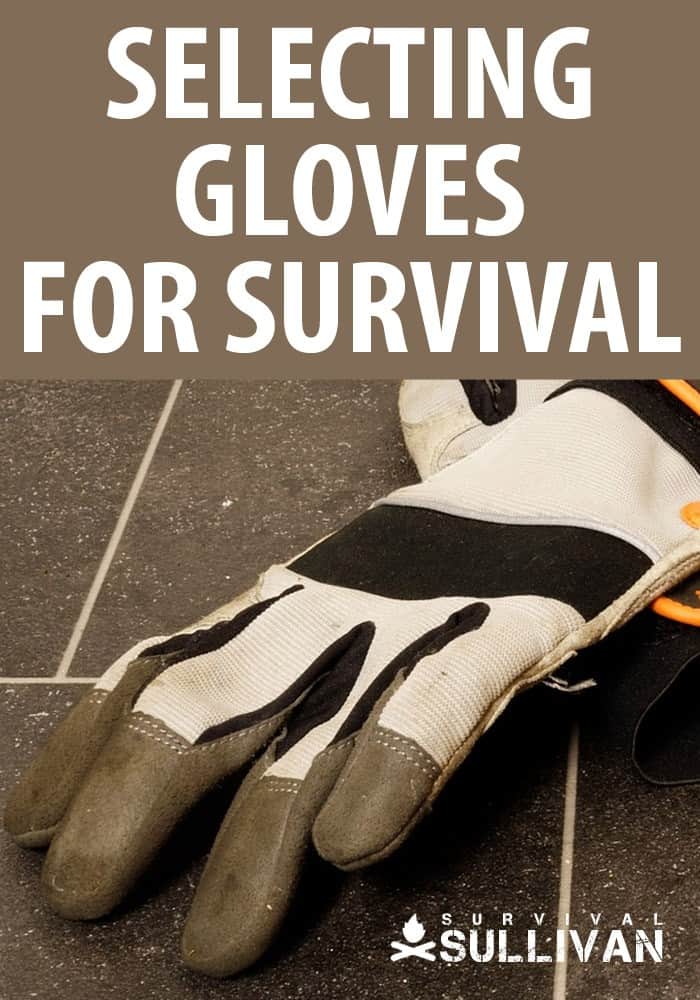Like all pieces of personal protective equipment, or PPE, gloves are an item you don’t need until you do, then it is too late.

Considering that our hands are the principal way we interact with the world around us, directly or with tools, it is a good idea to protect them from harm, thereby enabling us to work harder, longer, and with less chance of injury.
Thusly, for anyone, to say nothing of someone actively preparing for any emergency or crisis, to have gloves close at hand (ha!) is common sense.
However, great differences exist between gloves of various makes and brands, and knowing what type of build and material is ideally suited to your anticipated use is important for safety, comfort, and durability.
My Top Survival Gloves Picks
Talking about any category of equipment, there are some products that establish themselves as a consistent, quality choice. Gloves are no different. Some may be iconic, and others known only to dedicated professionals or enthusiasts.
Below you will find gloves from a few categories that I have either used extensively myself or have the near-universally good reviews from a variety of sources.
Disclosure: This post has links to 3rd party websites, so I may get a commission if you buy through those links. Survival Sullivan is a participant in the Amazon Services LLC Associates Program. As an Amazon Associate, I earn from qualifying purchases. See my full disclosure for more.

Favorite All-Purpose Glove: Mechanix Wear Originals
Many of you probably saw this coming. For a dependable, affordable technical glove, suitable for light labor, shooting and keeping your hands protected from scrapes.
Affordable, found everywhere, and available in myriad varieties, sizes, and colors, so you can get ones that are a little more rugged, or very light and supple, with or without the Velcro wrist closure. I have gone through a dozen pairs over the years.
Favorite Work Glove: Magpul Core Ranch Gloves
I am a convert on these: I have long preferred goat -or deer-skin leather for my work gloves, as it offers significant cut and abrasion resistance over most natural or synthetic fibers.
I had long used any decent brand I could get at the local home-improvement superstores, but decided to try these on a whim, being one of the few leather work gloves that features a touch-screen compatible fingertip.
The quality and durability have been top-notch, and they are long-wearing. The fit is also close enough that they would not totally screw you if you needed to use a gun. Modestly priced, get yourself a pair to keep in your go-bag.

Favorite Shooting-Specific Glove: PIG FDT Gloves
Expensive for what they are, but really do live up to the hype, at least in this humble author’s opinion.
A technical glove made with superb attention to human engineering and synthetic materials, these were designed from the ground up to give maximum sensitivity and feel for using a handgun or long gun.
Supremely comfortable. Be warned, they do not last much longer than most typical technical gloves, but if you are an armed professional or gun-centric individual these may be worth the price.

Best Impact Protection Glove – Mechanic Wear M-Pact
A sensible iteration of the classic mechanic’s gloves, the M-Pact series lives up to the moniker with heavy-duty nylon and rubber impact bumpers across the back of the knuckles and three fingers on one side, with thick closed cell padding on the interior leather palms.
The supple texture these gloves are famous for means you’ll keep your grip even as breathable, lightweight fabric all around means your skin won’t be smothered even as these gloves protect you.
Available in all kinds of colors and varieties to suit any objective, job or desire, this is a great way to add protection without sacrificing dexterity.
The latest generations of this glove are touch-screen compatible so you don’t have to shut the glove to interact with your device or cell phone. Get the Mechanic Wear M-Pact here.

Best Cold Weather Glove – 5.11 Tactical Caldus
Another win from 5.11, the Caldus cold weather glove represents a major leap forward and it weather protective gloves that gives up very little in terms of dexterity.
Affording excellent cold weather protection thanks to 40g weight Thinsulate C100, the stretch knit back panel, reinforced goat skin palm, knuckles and fingers provide excellent touch sensitivity.
For use in icy, snowy or cold and wet weather this glove can hardly be beat, particularly if you still need to use firearms or perform other sensitive, dexterous tasks.
Unlike most technical cold weather gloves worn by hikers, climbers and other outdoor explorers, these have the durability to stand up to hard use and rough, abrasive surfaces time and time again. Get the 5.11 Tactical Caldus here.
What is the Task at Hand?
The amount of gloves on the market today is nothing short of staggering, with seemingly an endless variety of brands to choose from for any conceivable climate or purpose.
Before you set off trying to parse out which is best for you, consider the likely scenarios in which you will need them.
Think about the weather conditions you will be experiencing. Are there any required features or secondary tasks that the gloves need to accomplish simultaneously?
What is your budget? Are you best served buying one pair of top-tier gloves or a couple, lesser pairs if you think they will not survive long in service?
An example of secondary features one may require would be enhanced dexterity, a touch-screen capable fingertip, melt resistance, cut/puncture resistance or the like.
You may want a padded palm for using manual tools, or hard knuckles and joint protection for hands-on attitude adjustment.
This is totally dependent on your occupation, or anticipated scenario. For instance, I am usually carrying concealed or using a gun on a regular basis, and big, chunky gloves can hamper this significantly.
Most of my gloves, even my heavier, leather work gloves are tailored to fit my hands closely and allow me to access my gun’s controls without a hitch.
Sometimes those features are difficult or impossible to get in the same pair: You will find few gloves rated for deep-cold that offer second-skin like dexterity.
Flame-resistant gloves are typically only offered in a few types of material, and can often be expensive.
Very dexterous gloves are usually made from thin and supple material, and are quickly chewed up by serious manual labor or handling sharp or rough material. Life is about trade-offs, and choosing your gloves is no exception.
Most often you will be able to choose a pair that can adequately cover a range of situations, but not always. If that is the case, you may decide to take two, one to cover additional situations or make up for the shortcomings of the other.
Be smart; gloves weigh very little and take up hardly any room in a pack, but it is easy to go overboard. If you aren’t stashing them in a vehicle or cross-loading them in multiple go-bags, make sure you are justified in having redundant pairs.
Also keep in mind that, used properly and often, gloves do wear out. Treat them like consumables, don’t spend so much on a pair of gloves that you cannot stand to see them torn up or abused.
That would obviously defeat the purpose; exposing your skin to spare your fancy gloves.
Basic Varieties of Gloves
Glove designs run the gamut from the very basic to extremely technical.
This overview is far from exhaustive but will cover the types that the average prepper already has in their possession or will consider purchasing. Keep in mind you may require something more specialized.

Work Gloves – These can come in varieties ranging from simple, jersey-knit cotton to heavy leathers and hides.
Their purpose is the same: give your hands protection from sharp or rough materials, branches, rock, lumber, debris, and so forth, and some protection from your tools, either blisters or sharp edges.
Quality varies wildly in this category and for leather, the type and weight make a difference both in feeling and durability.
The classic yellow “rancher” gloves are a great all-around glove for many kinds of outdoor work, and widely available; If of quality and given proper care, they can last a long time.
Technical Gloves – These are thin, typically synthetic gloves, usually featuring a slightly textured, grippy palm.
These are designed to offer very good dexterity for fine manipulation of tools, including guns, and parts. Most offer enough protection to prevent skinned knuckles and scrapes.
Some feature leather or reinforced palm, and may have additional padding for any combination of palm, fingers or back of the hand.
Gloves of this type make a fine, all-purpose selection, and thinner ones can even be used as a liner for heavy or cold weather gloves. Do not expect any gloves of this type to last more than a few months if used constantly.
Cold Weather Gloves – As the name suggests these are gloves suitable for insulation in cold weather. Some may feature waterproofing for dealing with work outside in the snow.
Take care in selection if dexterity is required, as many are bulky, and not necessarily suited to hard use. Durability and tear resistance will vary depending on materials used.
Tactical Gloves – I have included these in a separate category only because they are marketed accordingly.
Most have DNA taken from both technical and work gloves, i.e. they allow great dexterity and may be somewhat more durable than the average technical glove.
Typically found with back of hand and knuckle reinforcement. Expect to pay a premium for some brands.
Note that many times a simpler, cheaper glove is the best option! Don’t get taken by slick marketing and the fact that a particular military unit or celebrity trainer uses Brand X; be sure they articulate why they are the best for their purpose. Yours may very well be different.
Flame Resistant and Flame Retardant Gloves – Not the same thing! Flame Resistant gloves are made from material that is inherently nonflammable, and will not melt when in close proximity to flames or extreme heat.
Note that these materials may burn, but will typically do so slowly.
Flame Retardant gloves are instead treated chemically to be slow-burning or self-extinguishing. Know the difference, and consult experts in their use before you trust your hands to one or the other!

Disposable Gloves – Gloves are typically seen in doctor’s offices, hospitals, and adorning the hands of nurses and EMTs, or in your own first-aid kit (you do have a first-aid kit, right?)
May be made of latex, nitrile or vinyl. For medical purposes, latex and nitrile are most common, with nitrile being superior overall owing to its enhanced durability, typical lack of allergy response and impermeability.
Vital to have when working around blood, bodily fluids, and impromptu liquid or chemical spills, as other types of gloves will soak up liquids.
Be sure you know exactly what these will, and will not protect you against. A must-have no matter who you are.
Quality Matters: Construction and Selection
When choosing your gloves, be honest about your needs, and the intended use: A dollar store pair of jersey work gloves may be fine to keep your hands clean when changing a tire, or raking the lawn, but will fall short on durability.
Common leather work gloves can certainly suffice for getting dirty, rambling through the woods and may be worthwhile to have as supplements to another, nicer pair as backups or supplements, but generally won’t survive getting wet more than once or twice without deforming significantly.
Many of us that practice a responsibly prepared lifestyle will necessarily have weapons close at hand.
Ergo our choices will often revolve around a technical glove that will not hinder our use of guns or knives. This is a fine idea, but you should also stress test your gloves for durability, especially for abrasion under load.
Many will degrade surprisingly quickly under that kind of work, and we will be wearing our gloves most of the time for mundane tasks, not actively shooting with them. Make sure they hold up satisfactorily.
If you are purchasing gloves with flame-resistant qualities, find out precisely what they will tolerate; even the same material in a different brand may have significantly lesser protective qualities.
If the gloves claim imperviousness to water, are they waterproof, or merely water resistant? Test them carefully! A live event is no time to be learning your gear’s limitations!
A quick note on disposables: if you anticipate using your disposable gloves for chemical protection, again, take the time to know what chemicals will degrade your gloves, and under what kind of time frame.
If a serious biological or chemical hazard is part of your planning, you may very well want to look at heavier, purpose-made chemical protection gloves.
That could be another article in itself, but selection charts are easily found on the internet.
As with all our equipment choices, quality speaks. Learn about the differences between different leathers, cotton and synthetic blends, and what that means for the lifespan and use of your gloves.
You should pay attention to stitching, particularly the size and spacing of the thread itself. Widely spaced, scrawny thread is not an indicator of quality.
I once had a set of gloves with hard knuckles that, under sharp impact, broke the pitiful stitching around knuckle shell which then flew right off the top of the glove. “Disappointing” did not begin to describe it. I have not bought any from that maker since.
If you must be able to use a smartphone or similar touch-screen device without de-gloving, make sure any pair you choose has conductive thread woven into the fingertips.
What Gloves Are Right for You?
For the average person, gloves are simply for the protection of our hands, but for the prepared they are insurance against injury, injury that could spell infection, or a disability that prevents you from using your tools.
You have more choices than ever, but it is my hope that armed with this simple guide, you will have an easier time narrowing down your selection, and choosing wisely. Your hands are not so tough that they need no protection from the world’s sharp edges. Glove up!


Chad Nabors specializes in firearms, with a strong focus on concealed carry and pistols. His background is in commercial sales and training, and armor development and testing. He has trained many citizens on the pistol from basic to advanced skills. He is a vociferous proponent of the 2nd Amendment, and believes that defense of self and family is a moral obligation. He can be reached at grimgunner (AT) gmail.com.

Good info! Thanks for the article & the suggestions. Will be adding the recommendation for the work glove to the Want List for sure!
Great article. I live in S.E. Alaska and have a plethora of different gloves for different tasks and thus year found myself carrying two different sets in my hunt pack. I believe I will order a pair of the Magpull and see how those work.
I have gloves for different applications. My problem is finding pairs that fit small female hands. Do the Magpul gloves come in smaller sizes?
I can not access the secure order page for Lost Book of Remedies
I have dive gloves in my get home bag. It’s ok if they get wet. I’ve used them with a glove liner to handle hot pots. Also,they are lightweight and flexible because only the palm is leather.
The Mechanix M Pacts are the superior choice. I don’t agree with this author at all